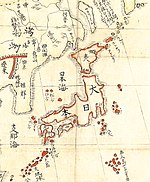Kofun period
| History of Japan |
|---|
 |
The Kofun period (古墳時代, Kofun jidai) is a time in the history of Japan from around 250 to about 538.[1] This grouping of years is named after the type of Imperial burial mounds called kofun which were raised in central Japan.
The Kofun period and the Asuka period are sometimes considered together as the Yamato period.
Timeline[change | change source]
The word kofun is Japanese for the type of burial mounds dating from this era.[2]
- 416: The earliest recorded earthquake in Japan destroyed the Imperial Palace in Kyoto.[3]
- 593: Prince Shotoku is regent
- 607: First ambassadors from Japan are sent to China
References[change | change source]
- ↑ "Kofun and Asuka Periods," Library of Congress Country Studies, Japan.
- ↑ Hall, John Whitney. (1991). Japan: From Prehistory to Modern Times, p. 21.
- ↑ Hammer, Joshua. (2006). Yokohama Burning: The Deadly 1923 Earthquake and Fire that Helped Forge the Path to World War II, p. 62.
Other websites[change | change source]
![]() Media related to Kofun period at Wikimedia Commons
Media related to Kofun period at Wikimedia Commons
- Metropolitan Museum of Art, Kofun period
- British Museum, Kofun period Archived 2011-08-01 at the Wayback Machine
- Japan-guide.com, Early Japan
